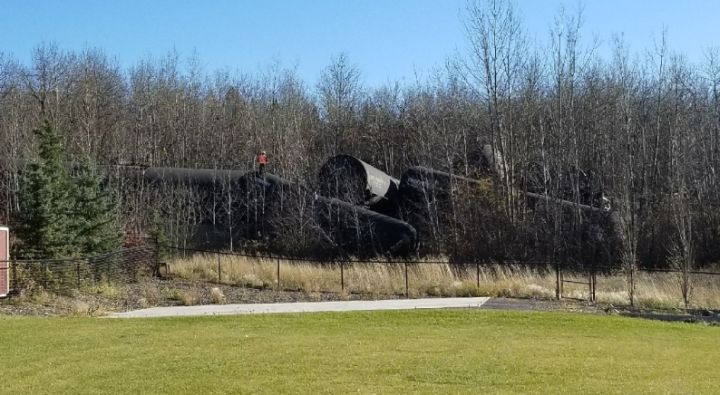One month after a train carrying crude oil derailed in Sturgeon County, the Transportation Safety Board of Canada (TSB) says an inspection of the track in the area — completed by Canadian National Railway (CN) in September — showed “rail wear limits” had been exceeded and that the condition of the high rail had reached “condemning limits.”

“Given the unpredictable growth rates of transverse defects, CN may wish to review the timeliness of the replacement of identified worn and/or fatigued rails on secondary lines where dangerous goods are transported,” the TSB said in a Nov. 2 letter addressed to CN and posted to its website.
“The rail was scheduled to be replaced as part of a rail replacement project in the corridor and that work was completed immediately after the incident,” CN added, confirming the derailment was caused by a broken rail.
On Oct. 22, dozens of homes in the Sturgeon Valley were evacuated after a train carrying crude oil derailed nearby. CN said between 50 and 100 litres of oil had spilled. The RCMP said 12 cars came off the tracks.
READ MORE: Cleanup continues after train carrying crude oil derails north of Edmonton
Watch below: On Oct. 23, 2017, Sarah Kraus filed this report the day after a dozen train cars derailed north of Edmonton. Some of the derailed cars were leaking oil.

The TSB said unlike in the deadly 2013 derailment in Lac-Mégantic, Que., the train involved in the Sturgeon County derailment, which occurred just north of the Campbell Park Station, involved “heavy, tar-like” crude oil, which presented a “lower risk to public safety.”
READ MORE: Audio recordings of Lac-Mégantic train engineer, dispatcher presented at trial
According to the TSB, testing completed prior to the derailment also revealed a number of breaks on the line near the point of derailment.
“In 2017, prior to the occurrence, seven rail flaw defect tests had been conducted,” the TSB’s letter said. “The test closest to the date of the derailment had been performed on Sept. 14, 2017. In the vicinity of the point of derailment, the test had identified detail fracture defects at Mile 8.59 and Mile 8.62, as well as a bolt hole defect at Mile 8.75.
“In this occurrence, CN’s inspection protocols had identified the condition of the high rail, which had reached condemning limits. However, the identified section of rail had not yet been replaced.”
“CN is committed to learning from every incident and we will continue to invest in new technologies that further improve our ability to detect track defects and address them as soon as possible,” CN said.
On Sunday, the mayor of Sturgeon County tweeted she plans to get answers about how CN will make improvements to its protocols going forward.
“Disappointing,” Alanna Hnatiw tweeted. “We’ll be in contact with all involved to get an explanation and details on how CN will ensure they improve their safety, maintenance, and communication procedures.”
The TSB said the train was moving at just over 33 kilometres per hour at the point of derailment.




Comments